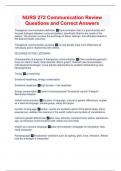NURS 272 Communication Review Questions and Correct Answers Therapeutic communication definition ✅Communication that is a goal directed and focused dialogue between nurse and patient, specifically fitted to the needs of the patient. The process involves the exchange of ideas, feelings, and attitudes related to the desired health outcomes Therapeutic communication purpose ✅To help people cope more effectively as individuals and in relationship with others. REQUIRES ACTIVE LISTENING Characteristics & purpose of therapeutic communication ✅Client -centered approach: focus on client's needs, Goal directed: Who's goals?, Defined rules & boundaties, Individualized strategies: nurse adjusts approaches as needed individualizing care, Nonjudgmental Timing ✅is everything Emotional readiness, energy conservation Emotional readiness ✅high anxiety = low readiness Energy conservation ✅Level of consciousness? Emotional trauma? Fatigue? Remember Maslow Verbal communication ✅Function of language, cultural & gender differences, english as a second language, paralanguage, slang and jargon function of language ✅verbal - words are symbols used to think about ideas, share experiences, validate the meaning of the world. Letters are symbols of vocalizations. cultural & gender differences ✅also race, ethnicity, socioeconomic status, educations, age, all influence communication both verbal and nonverbal english as a second language ✅allow time between messages for translation. May need interpreter Paralanguage ✅Vocalization variations such as sighing, pitch, tone, inflection. Affects how the message is interpreted Slang and Jargon ✅Avoid using in the profession with clients. For successful interaction, words must have same meaning. Nonverbal communications ✅body language (proxemic), cultural & gender differences, interpreting cues and facial expressions, clothing/grooming body language (proxemic) ✅often conveys true emotional content Cultural & gender differences ✅Decoders as above, who uses nonverbal more? Gestures vary by culture. Eye contact also varies, as does touch. Interpreting cues and facial expressions ✅Cues are the posture of the person, the rhythm of movement, gestures, stance, eye contact. Direct USUALLY means person is more confident. Evasive eye contact should be noted. Note the corner of the eyes and mouth for emotions. Clothing/grooming ✅Color, style, fit, cleanliness, general grooming. Tells much such as mental status, economic status personality, etc. Active listening ✅dynamic process - when a person hears a message, decodes its meaning, and conveys understanding about the meaning to the sender. Requires presence. Hears client's message ✅beyond listening, attached to thoughts, emotions, vlues Decodes its meaning ✅Takes verbal and nonverbal and constructs meaning Provides feedback ✅for the client concerning nurse's understanding of the message SOLER position ✅five behaviors that demonstrate active listening. They are nonverbal and show empathy. S: sit square or at an angle so you face the person O: open posture, not crossed arms or legs L: lean forward a bit E: eye contact to comfort of patient R: relax, no fidgeting Questions to start therapeutic communication ✅Questions are only ONE way to obtain information and they do not always obtain the best information Open -ended questions ✅Cannot answer yes or no. They are open to interpretation Closed question ✅Yes or no answer. Limited in the information they will obtain. Focused questions ✅Limiting, but answer is more than yes or no Example: "what is your birthday" "Where were you born" Communication assessment VERBAL ✅language, fluency, accents, organization (thought processing)? Communication assessment WRITTEN ✅able to write and/or read? How much? how well? what level? Communication assessment NON -VERBAL ✅gesture, congruence to verbal Communication assessment ENVIRONMENT ✅Hospital (type of unit), clinic, long term care, community, patient's home - respect their space and belongings. Ask permission in their space and belongings Infants ✅nonverbal, gentle motion, parents are partners, slow & soft voice, sit at level or hold in arms when trust is established Toddlers 1 -3 yrs ✅brief & clear, simple complete sentence in the child's words, no "baby" talk, show hands, allow some choices (do you want a half or whole glass of milk?), address parents first in voice and in location, sit down and join the child in play. Preschoolers 3 -5 yrs ✅Simple words, brief and concrete explanations, play therapy for explanations (doll or bear), provide choices, attending posture (presence), tell jokes School age 5 -10 yrs ✅Include child in care & explanations, draw pictures, use some of their words, privacy. 11 and older ✅Abstract thinking can be used, but to a minimum, use humor, privacy, state limits of confidentiality, allow participation in decision making, attending posture, active listening. Elderly ✅Do not lose intelligence, may be some retrieval slowness. Most like to tell their stories. May see sensory losses and cognitive disease more with the elderly Visually impaired ✅let them know when and who is entering and leaving their area, normal tone of voice, explains touching before it is done, orient to environment, call light within reach, if partial vision: stay in visual field, ambulates with the patient holding your arm, may use braille, books on tape, music, read to pt




